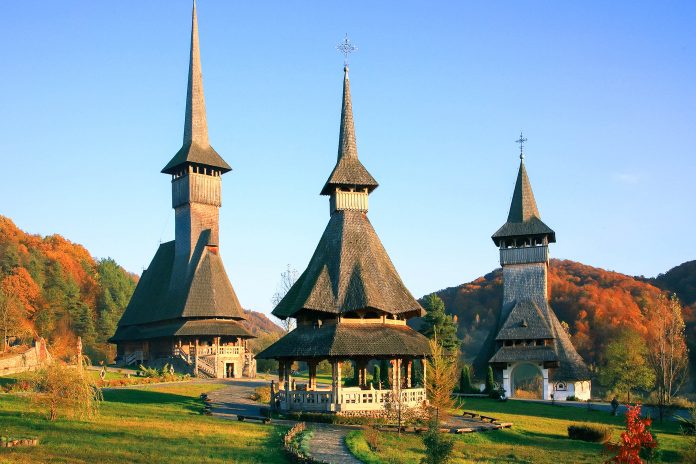Die Holzkirchen in den Maramureș im Norden Rumäniens stammen aus dem 17. und 18. Jahrhundert und beeindrucken durch meisterhafte Architektur und wunderschöne Malereien.
Die Holzkirchen in der Region Maramureș zählen etwa 60 hölzerne Kirchengebäude aus dem 17. und 18. Jahrhundert. 45 davon liegen auf rumänischem Staatsgebiet, 15 in der Ukraine. Acht rumänische Holzkirchen wurden im Jahr 1999 als typisch rumänische Sakralarchitektur von der UNESCO zum Weltkulturerbe erklärt. Die dank ihres hohen spitzen Turms weithin sichtbaren Holzkirchen haben ihren Platz auf unserer Liste der Top 10 Sehenswürdigkeiten von Rumänien.
Inhaltsverzeichnis
Geschichte der Holzkirchen in den Maramures
In Siebenbürgen war es früher verboten, orthodoxe Kirchen aus Stein zu errichten, also griffen die Gläubigen auf Buchen-, Eichen-, Tannen- und Ulmenholz zurück. Über 200 Jahre lang wurden die Holzkirchen in der Maramureș in nahezu jedem Dorf mit den unterschiedlichsten Stilelementen errichtet. Charakteristisch sind ihre hohen, schlanken Kirchtürme an der Westseite.
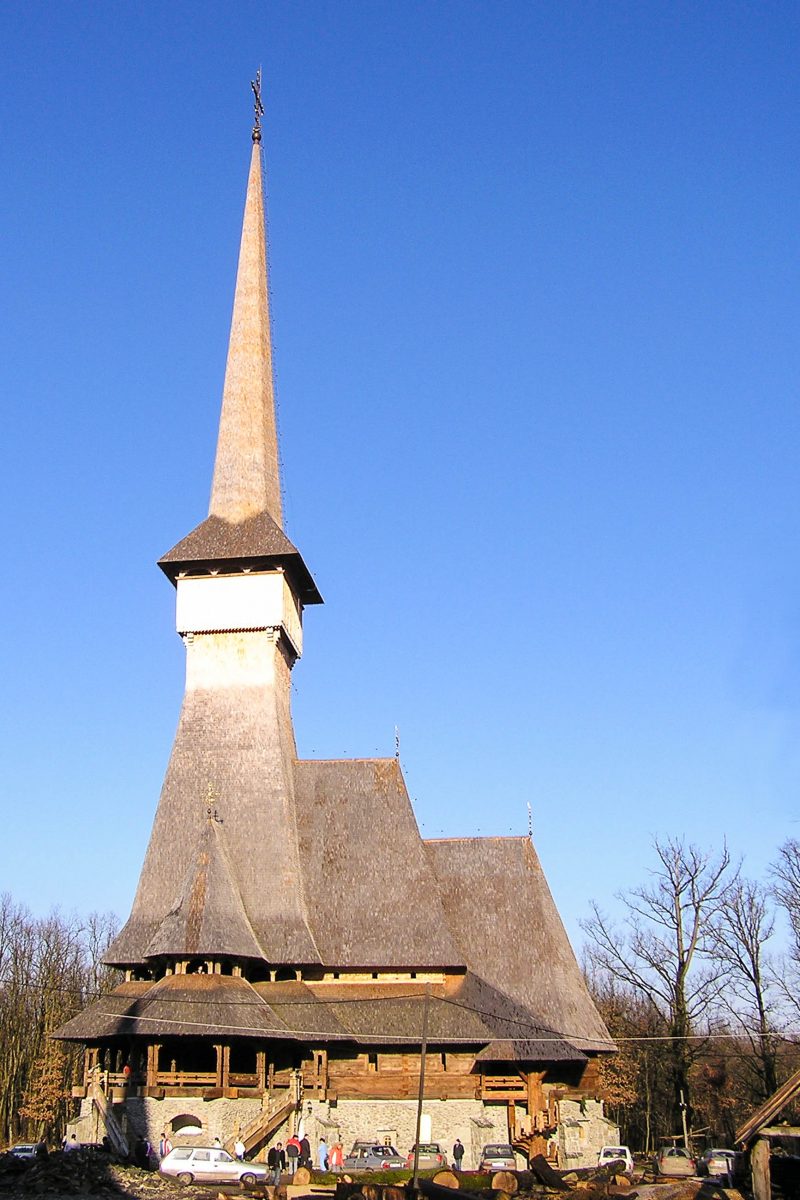
Mit der Zeit wurden die Holzkirchen immer besser gebaut und mit meisterhaften Schnitzereien verziert. Manche Tischler lebten plötzlich vom Kirchenbau. Einige der Kirchen sind klein und dunkel, doch manche weisen erstaunliche architektonische Elemente auf. Die riesigen, meist schindelgedeckten Dächer und der hohe Turm lassen die eigentliche Kirche zwergenhaft erscheinen.
Die einzige Kirche ohne Glockenturm befindet sich in Cuhea, wo stattdessen ein so genanntes Stundenholz geschlagen wurde, um die Messe „einzuläuten“.
Die Innenausstattung gleicht der eines „normalen“ orthodoxen Kirchengebäudes. Die Holzwände sind mit kunstvollen Fresken geschmückt, die Szenen aus dem Alten Testament und aus dem Leben von Heiligen zeigen.
Wo sind die schönsten Holzkirchen Rumäniens zu finden?
- Zum UNESCO Weltkulturerbe zählen die Holzkirchen in den Ortschaften Bârsana, Budeşti-Josani, Deseşti, Ieud-Deal, Plopiş, Poienile Izei, Rogoz und Şurdeşti.
- Als Paradebeispiel für die Architektur der Holzkirchen der Maramureș gilt die Holzkirche „Sfinţii Nicolae“ in Budeşti-Josani aus dem Jahr 1643.
- Als schönste Holzkirche wird die „Naşterea Fecioarei“ in Ieud-Deal bezeichnet.
- Die älteste Holzkirche der Maramureș ist die „Sfânta Paraschiva“ in Poienile Izei, die aus dem Jahr 1604 stammt.
- Die höchste Holzkirche Rumäniens ist das Kloster des Erzengels Michael in Săpânța. Sie hält auch den Rekord des welthöchsten Bauwerks aus Eichenholz.
- Die höchste historische Holzkirche befindet sich in Şurdeşti. Ihr Spitzturm ist nur 6m niedriger als die Klosterkirche in Săpânța.
Holzkirche von Ieud-Deal

Die Holzkirche von Ieud zählt als älteste Holzkirche Rumäniens seit 1999 zum Weltkulturerbe der UNESCO. Die ursprüngliche Kirche „Nasterea Maicii Domnului“ wurde im Jahr 1364 errichtet und war damit die erste Holzkirche in den Maramureș.
Von dieser Kirche existiert jedoch nichts mehr und die heutige Biserica Ieud Deal („Kirche auf dem Hügel von Ieud“) stammt aus dem 17. Jahrhundert. Im Gegensatz zu den meisten anderen rumänischen Holzkirchen besteht die Holzkirche von Ieud nicht aus Eichen-, sondern aus Tannenholz.
BILDER: Holzkirche von Ieud
Fotogalerie: Holzkirche von Ieud
Besuch der Holzkirche von Ieud
Ieud liegt auf der Strecke zwischen Baia Mare und Sighetu Marmitiei. Kurz vor Vadu Izei befindet sich die Abzweigung in Richtung Barsana, das ebenfalls eine UNESCO-Holzkirche besitzt, und Ieud. Die Kirche von Ieud liegt etwas außerhalb inmitten üppiger Vegetation und einem kleinen Friedhof. Da sie auf einem Hügel erbaut wurde, ist die der Geburt der Jungfrau Maria geweihte Kirche auch als „Barcului“, „Kirche auf dem Hügel“, bekannt.
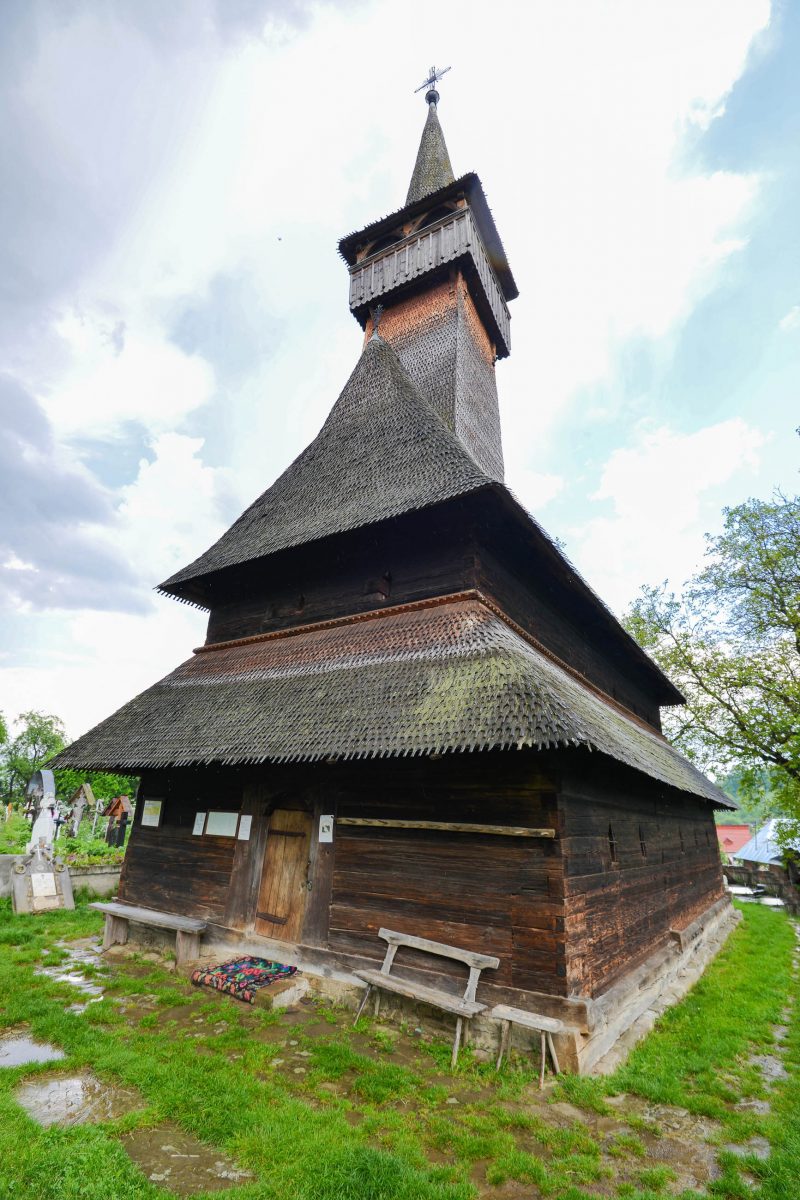
Die byzantinischen Malereien in der Holzkirche von Ieud sind um einiges jünger als die Kirche selbst, denn sie wurden erst 1782 gefertigt. Als Schöpfer ist Alexandru Ponehalschi überliefert, als dessen künstlerischer Höhepunkt die Kirche angesehen wird.
In der Vorhalle stellen sich die Sünder dem Jüngsten Gericht und im Langhaus dominieren Abbildungen der Heiligen Dreifaltigkeit und Szenen aus dem Alten und Neuen Testament.
Im Inneren der Kirche von Ieud beeindrucken jedoch nicht nur die Fresken, sondern auch kunstvolle Teppiche, die von Hand geknüpft und mit pflanzlichen Farben gefärbt wurden, wertvolle Ikonen aus Glas und kostbare, ebenfalls pflanzlich gefärbte Bücher aus dem 15. Jahrhundert.
Der größte Schatz der Kirche ist das Manuskript „Codicele de la Ieud“ aus dem Jahr 1391, welches 1921 durch Zufall auf dem Dachboden des Holzbaus entdeckt wurde und das älteste Dokument in rumänischer Sprache darstellt. Der Kodex von Ieud befindet sich heute in Bukarest in der Bibliothek der rumänischen Akademie.
Holzkathedrale im Zentrum von Ieud
Auch im Ortskern von Ieud wartet eine Holzkirche auf Besucher. Diese wird bis heute als Gotteshaus genutzt und stammt aus dem Jahr 1718. Als eine der größten Holzkirchen der Maramureș wird sie auch als „Holzkathedrale“ bezeichnet.
Ein Besuch der Kirche lohnt sich ebenso, denn das gesamte Dorf Ieud ist aufgrund seiner historischen Bauten ein regelrechtes Freilichtmuseum und zählt malerisch am Oberlauf der Iza gelegen zu den wichtigsten Touristenzielen Rumäniens.
Holzkirche von Poienile Izei
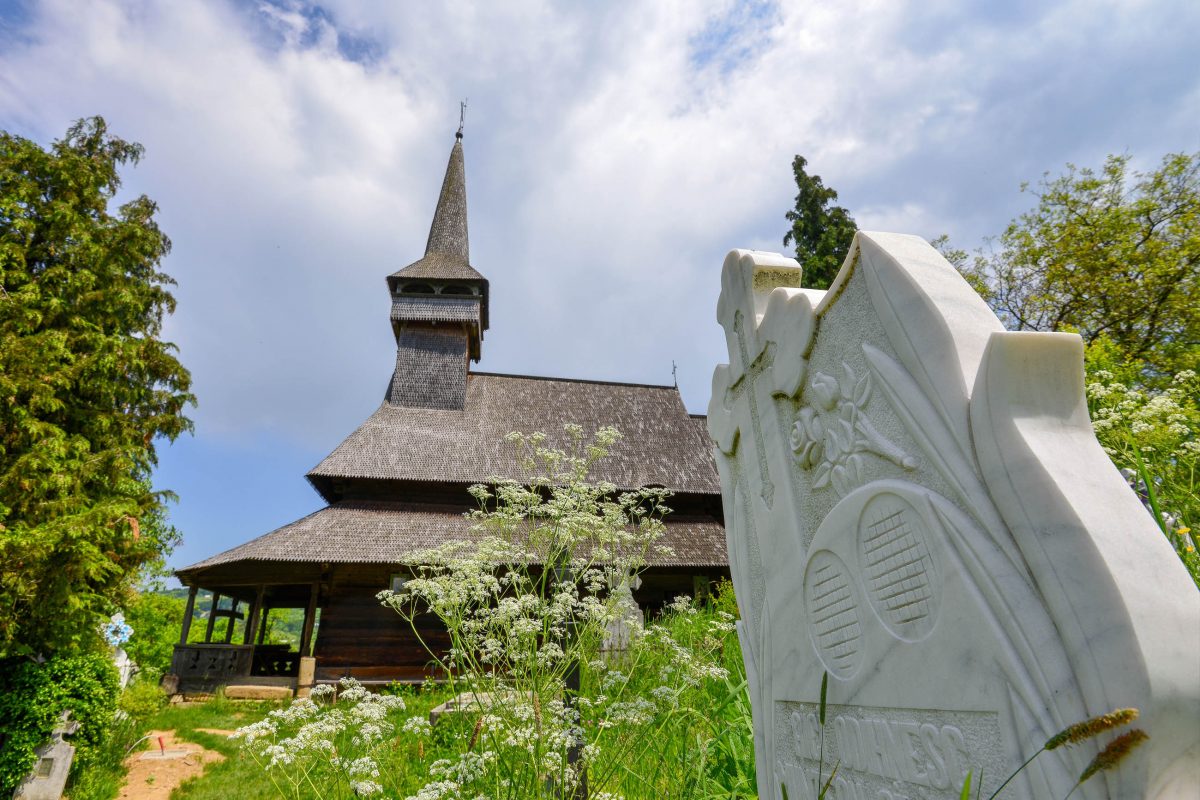
Die Holzkirche Sfanta Cuvioasa Paraschiva in der schmucken Ortschaft Poienile Izei ist eine der interessantesten und besterhaltenen Holzkirchen Rumäniens. Mit ihren eindrucksvollen Fresken zählt sie zu Recht als eine der acht Holzkirchen der Maramureș zum Weltkulturerbe der UNESCO.
Sowohl die Fresken als auch der Baustil entsprechen exakt der Tradition und Kunst der Maramureș, was die Kirche von Poienile Izei zu einem wertvollen Denkmal der damaligen Zeit macht.
BILDER: Holzkirche von Poienile Izei
Fotogalerie: Holzkirche von Poienile Izei
Die Holzkirche von Poienile Izei thront auf einer kleinen Anhöhe mitten im Dorf. Sie wurde von 1604 bis 1632 „aus hundert Jahre alten Baumstämmen“ errichtet und 1637, ebenso wie die Holzkirche von Deseşti, der Hl. Paraschiva geweiht. Damit zählt sie zu den ältesten Holzkirchen der Maramureș.
Besuch der Holzkirche von Poienile Izei
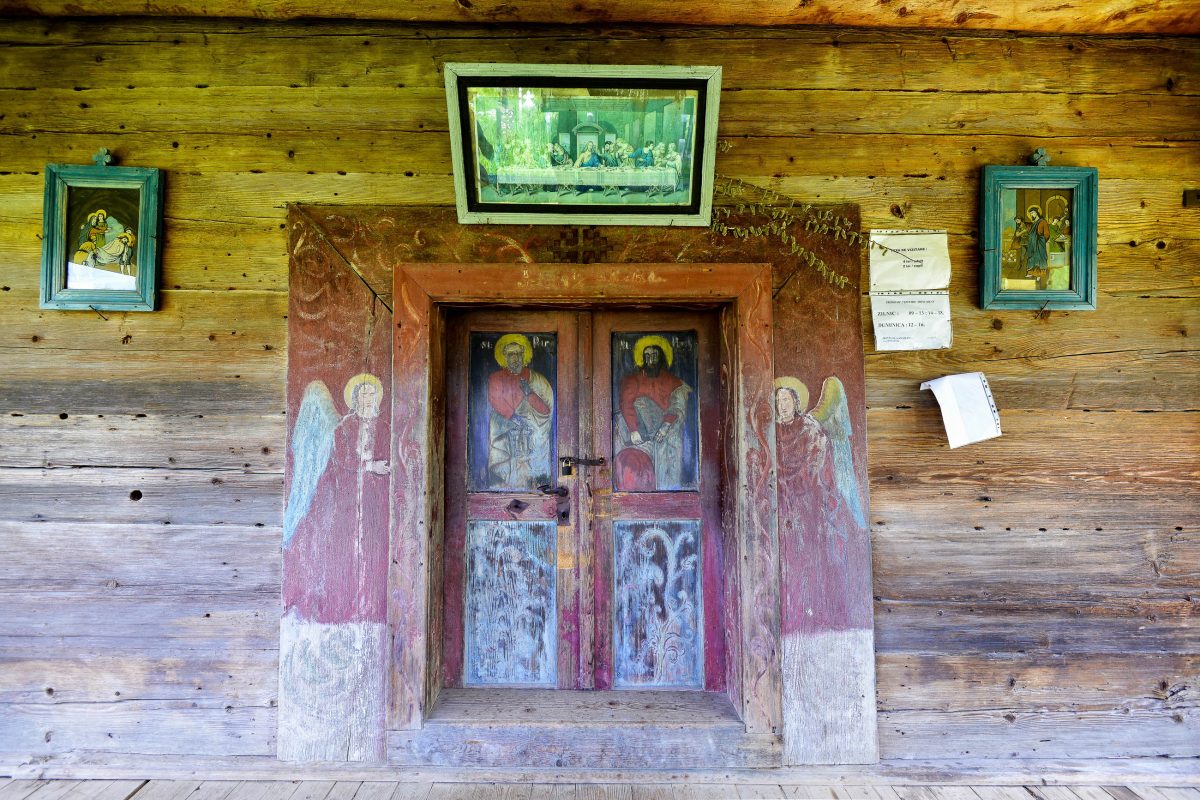
Bereits der Schmuck an der Eingangstür zur Holzkirche von Poienile Izei lässt auf die Malerei-Künste in ihrem Inneren schließen. Der gesamte Innenraum der eleganten Holzkirche ist mit zahlreichen kunstvollen Malereien übersät, die in erster Linie biblische Szenen zeigen und laut einer Inschrift an einem Altartuch aus dem Jahr 1794 stammen.
Im Vorraum ist das Jüngste Gericht dargestellt, welches auf eindrucksvolle Weise zeigt, was den armen Sündern in der Hölle widerfährt. Wer die Schreckensbilder genau betrachtet erkennt aufgeschlitzte Diebe, aufgehängte Lügner und eine Frau, die ihr abgetriebenes Kind schluckt.
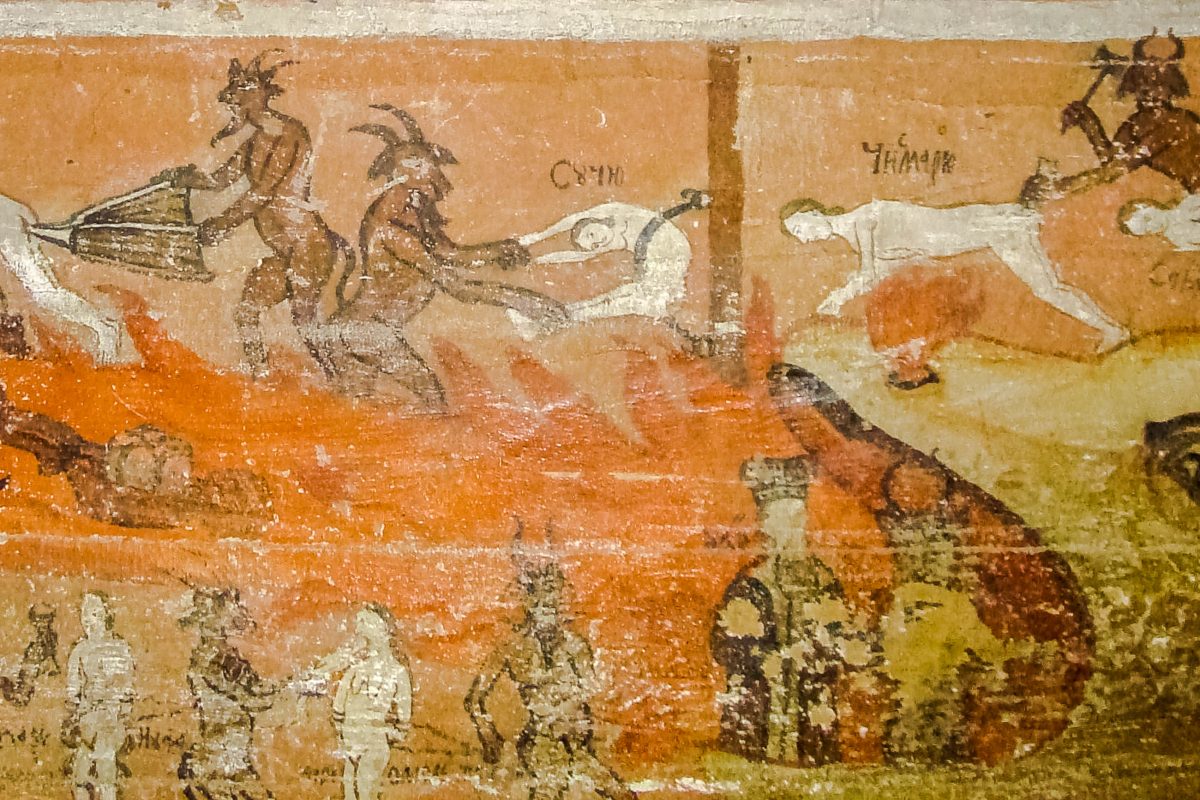
Im Hauptraum sind neben dem Leiden Christi mit Adam und Eva im Paradies, Mariä Himmelfahrt und der Hl. Paraschiva auch weniger gewalttätige Szenen dargestellt.
In der Umgebung der Holzkirche von Poienile Izei sorgen zahlreiche geschmückte Kreuze eines kleinen Friedhofs für eine malerische Szenerie, deren Idylle noch durch die üppige Natur rund um die kleine Kirche betont wird.
Kloster des Erzengels Michael in Săpânța

Das Kloster des Erzengels Michael (Sfântul Arhanghel Mihail) in Săpânța besitzt mit einer Höhe von 78 Metern die höchste Holzkirche in Rumänien und das höchste Eichenholzbauwerk der Welt.
Die Holzkirche von Săpânța wurde allerdings erst 2003 als absichtlich höchste Holzkirche fertiggestellt. Sie ist lediglich 6m höher als die berühmte Holzkirche von Şurdeşti, die für viele als Schönste aller rumänischen Holzkirchen gilt. Nach wie vor wird die Kirche auch als Kirche von Peri bezeichnet, da sie als Nachfolge-Kirche des Klosters von Peri in der heutigen Ukraine gilt, die im Jahr 1703 zerstört wurde.
Das Kloster des Erzengels Michael ist zwar aufgrund seiner Größe beeindruckend, kann aber mit dem Flair der Jahrhunderte alten Kirchen des UNESCO-Welterbes nicht mithalten.
BILDER: Kloster des Erzengels Michael in Săpânța
Fotogalerie: Kloster des Erzengels Michael in Săpânța
Auch bei der Holzkirche von Săpânța hielten sich die Baumeister streng an die traditionellen Vorschriften. Die Kirche besteht zu hundert Prozent aus massivem Eichenholz, nicht einmal die Nägel bestehen aus Eisen. Seit 2005 werden die „moderne traditionelle“ Holzkirche sowie ein Wohnhaus und ein eigener Gebetsraum für den Sommer als Nonnenkloster genutzt.
Finanziert wurde der Bau der Kirche von Carmen und Grigore Adamescu, wie ein Schild verrät. Das millionenschwere Ehepaar verdiente ein Vermögen mit Bauprojekten, Immobilien, Hotels und Versicherungen und zählt zu den reichsten Geschäftsleuten Rumäniens.
Holzkirche von Șurdești

Die Holzkirche von Șurdești heißt eigentlich „Kirche der heiligen Erzengel Michael und Gabriel“ und zählt seit 1999 zum Weltkulturerbe der UNESCO.
Die Kirche in Șurdești, 20km von Baia Mare (Frauenbach) entfernt, wurde im Jahr 1766 von Ion Macarie aus Eichenholz errichtet und mit einem eindrucksvollen Turm versehen. Das charakteristische spitz zulaufende Dach erreicht eine Höhe von 54 Metern und ist an seiner Basis von vier weiteren kleinen Türmen umgeben.
Insgesamt ist die Kirche 72 Meter hoch und gehört damit zu den höchsten Kirchen in den Maramures. Weltweit ist die Kirche von Șurdești das zweithöchste Bauwerk aus Eichenholz. Sie wird nur – absichtlich – von der Klosterkirche von Săpânța geschlagen.
BILDER: Holzkirche von Șurdești
Fotogalerie: Holzkirche von Șurdești
Besuch der Kirche von Șurdești
Der Vorraum der Kirche ist für diese Art der Architektur ungewöhnlich und wurde erst nach Fertigstellung der Kirche angefügt. Die beiden Bogenreihen des Vorraums sind aufgrund ihrer Form und Dekoration ebenso bemerkenswert, wie die doppelreihigen Fenster und das Fries im Innenraum, das in Form eines gedrehten Taus gestaltet wurde.
Tipp: Wer die Holzkirche von Șurdești auch von innen besichtigen möchte, kann sich im Nachbarhaus nach dem Schlüssel erkundigen.
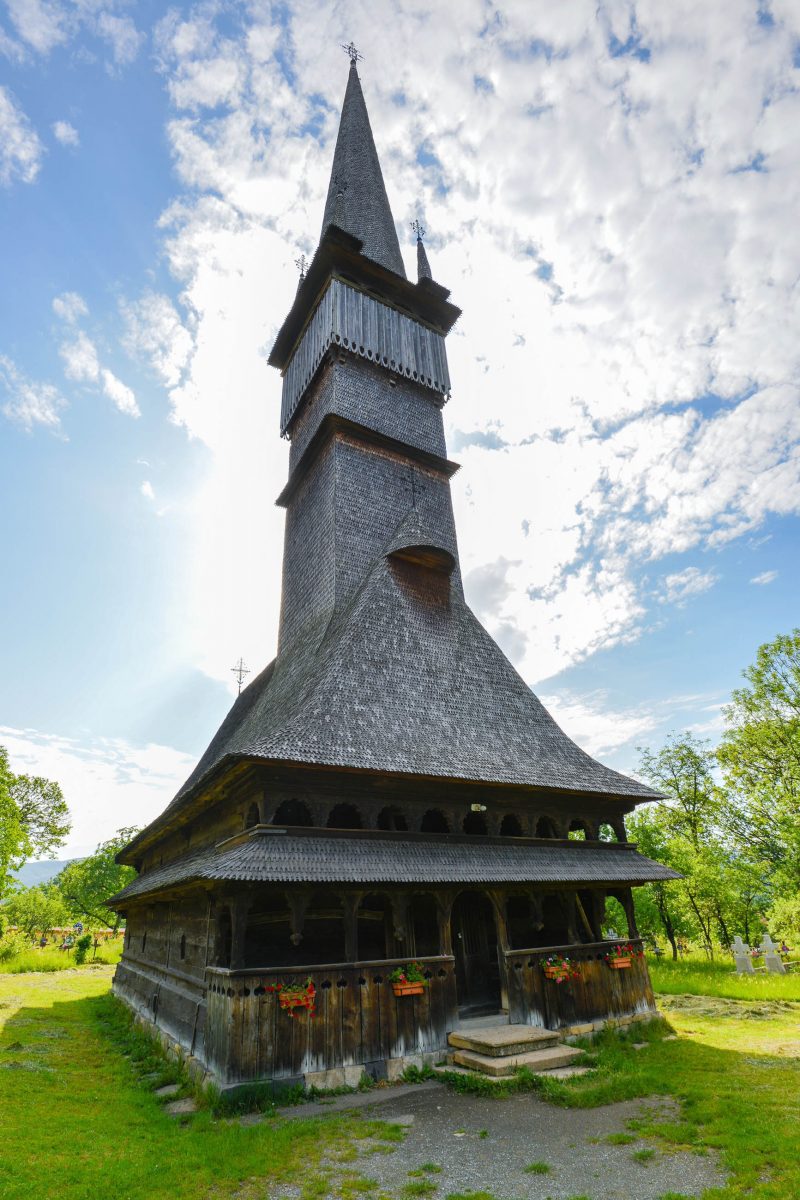
Die meisterhaften Wandmalereien im Inneren der Holzkirche von Șurdești stammen aus der Hand des Malers Stefan von Sisesti und wurden im Jahr 1783 vollendet, wie eine Inschrift auf der kunstvollen Ikonenwand verrät. Die Malereien zeigen Szenen aus dem alten und neuen Testament und blieben bis heute ohne Konservierung erstaunlich gut erhalten.
Ebenfalls kunstvoll anzusehen sind die gestickten Tücher, die zum Großteil von Frauen aus der Region in Handarbeit gefertigt wurden und einige Stücke aus dem 17. Jahrhundert beinhalten. Gemeinsam mit Heiligenbildern und Marienstatuen schmücken sie das Innere der Kirche, die mit den zahlreichen kunstvollen Objekten an ein Museum erinnert.
Rund um die Kirche ragen zahlreiche steinerne, eiserne und hölzerne Kreuze aus der Wiese, die auf einfachste Weise einen Friedhof bilden.
Holzkirche von Plopis

Nur einen Katzensprung von Șurdești entfernt beeindruckt die Kirche „Sfintii Arhangheli“ zwar nicht durch ihre Ausmaße, dafür aber durch ihr harmonisches Gesamtbild. Die römisch-orthodoxe Kirche ist den beiden Erzengeln Michael und Gabriel geweiht und ein prachtvolles Zeugnis der begabten Holzschnitzer von Plopis, für die das Dörfchen weithin bekannt ist.
Das Kirchenschiff ist mit einer Länge von 17 und einer Breite von 7 Metern verhältnismäßig klein. Der 47m hohe Turm fügt sich mit perfekt ausgewogenen Proportionen harmonisch in das Gesamtbild ein.
Die Holzkirche in Plopis wurde ab dem Jahr 1798 rein aus Eichenholz errichtet und am 12. November 1811 eingeweiht. Insgesamt trugen 49 Familien aus der Umgebung zur Finanzierung bei. Jede dieser Familien ließ damals eine Münze in der Kirche hinterlegen, die später gefunden wurden.
BILDER: Holzkirche von Plopis
Fotogalerie: Holzkirche von Plopis
Anreise nach Plopis
Für die Anfahrt nach Plopis seid ihr auf ein eigenes Fahrzeug angewiesen, da die winzige Ortschaft nicht an das öffentliche Verkehrsnetz angebunden ist. Von Șurdești auf der 182C kommend zweigt vor Faurești eine Straße ab, das letzte Stück ist nicht einmal mehr asphaltiert.
Besuch der Holzkirche von Plopis
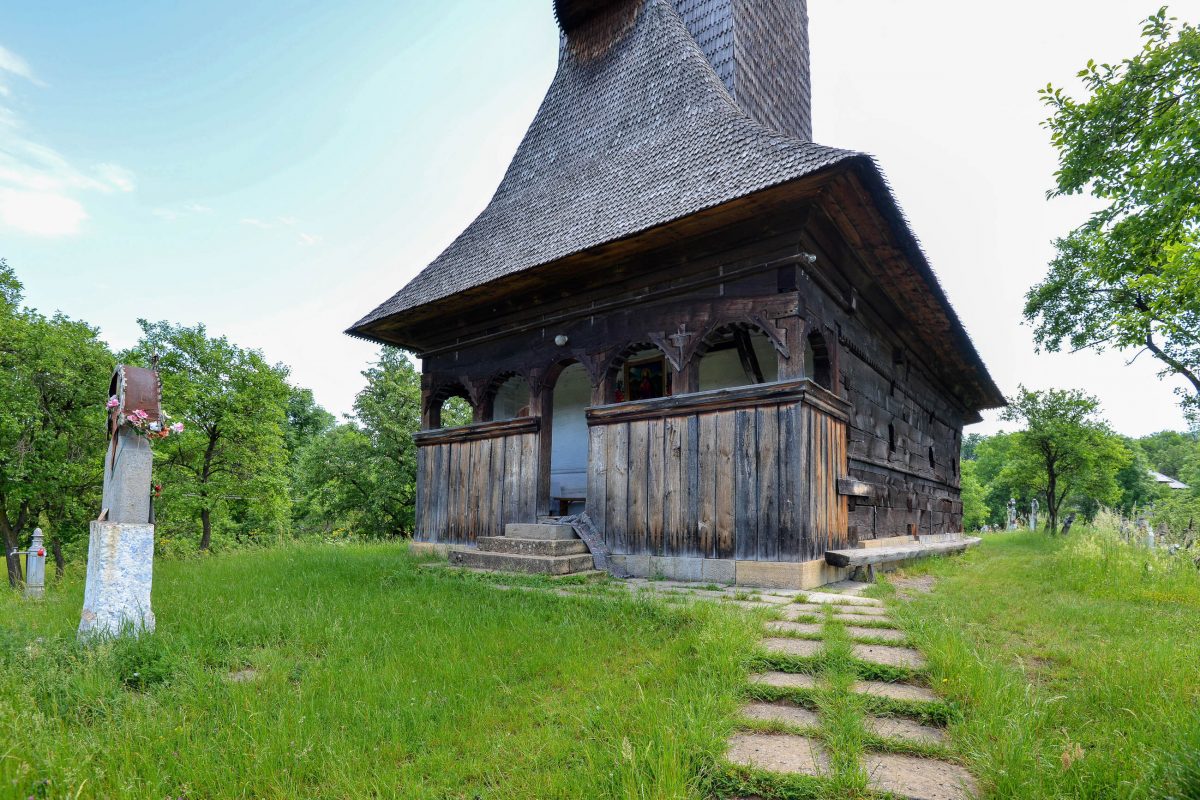
Tipp: Ist die Holzkirche von Plopis verschlossen, lohnt sich ein Besuch des Hauses gegenüber, wo nach dem Schlüssel gefragt werden kann. Die Kirche von innen zu betrachten, lohnt sich auf jeden Fall!
Im Inneren ist die Bemalung der Holzkirche von Plopis ein Meisterwerk für sich. Kein Wunder, wurde sie doch von Stefan Zugravul geschaffen, einem Nachfolger jener Zugravuls, die auch für die erstaunlichen Fassadenmalereien einiger der berühmten Moldauklöster verantwortlich sind.
Vor allem beeindrucken die gut erhaltenen Szenen des Jüngsten Gerichts, die die gesamte Westwand des Mittelschiffs einnehmen. Weitere Darstellungen zeigen die Passion Christi, die Vertreibung aus dem Paradies und Figuren der Heiligen Dreifaltigkeit, sowie die beiden Erzengel Michael und Gabriel.
Holzkirche von Bârsana

Auch die eindrucksvolle Holzkirche von Bârsana wurde 1999 zum Weltkulturerbe der UNESCO erklärt. Die elegante Kirche Intrarea Maicii Domnului în Biserică („Kirche Maria Tempelgang“) steht auf einem Hügel mitten in der Siedlung und lockt jedes Jahr tausende Touristen nach Bârsana. Ihr unverkennbarer Spitzturm ist schon von weitem sichtbar.
Im Gegensatz zu den meisten anderen Holzkirchen der Maramureș sind die einmaligen Fresken der Bârsana-Kirche nicht in byzantinischem, sondern barockem Stil gehalten. Dargestellt sind Szenen aus der Schöpfungsgeschichte und dem Jüngsten Gericht, sowie auffällige mit Augen übersäte Engelsgestalten.
BILDER: Holzkirche von Bârsana
Fotogalerie: Holzkirche von Bârsana
Geschichte der Holzkirche von Bârsana
Der prominente Platz in der Ortsmitte war allerdings nicht das angestammte Grundstück der Holzkirche. Die Errichtung der Kirche erfolgte bereits im Jahr 1720, damals als Klosterkirche des Klosters von Bârsana am südöstlichen Ortsrand. Das Kloster wurde jedoch Ende des 18. Jahrhunderts zerstört und erst 200 Jahre später wieder aufgebaut.
Die malerischen Bauten inmitten eines idyllischen Gartens sind übrigens ebenfalls sehenswert. Der weitläufige Klosterkomplex wurde erst in den 1990er-Jahren nach traditioneller Bauweise komplett aus Holz errichtet und zählt zu den schönsten Klosteranlagen Rumäniens.
Von der Klosterkirche zur Pfarrkirche
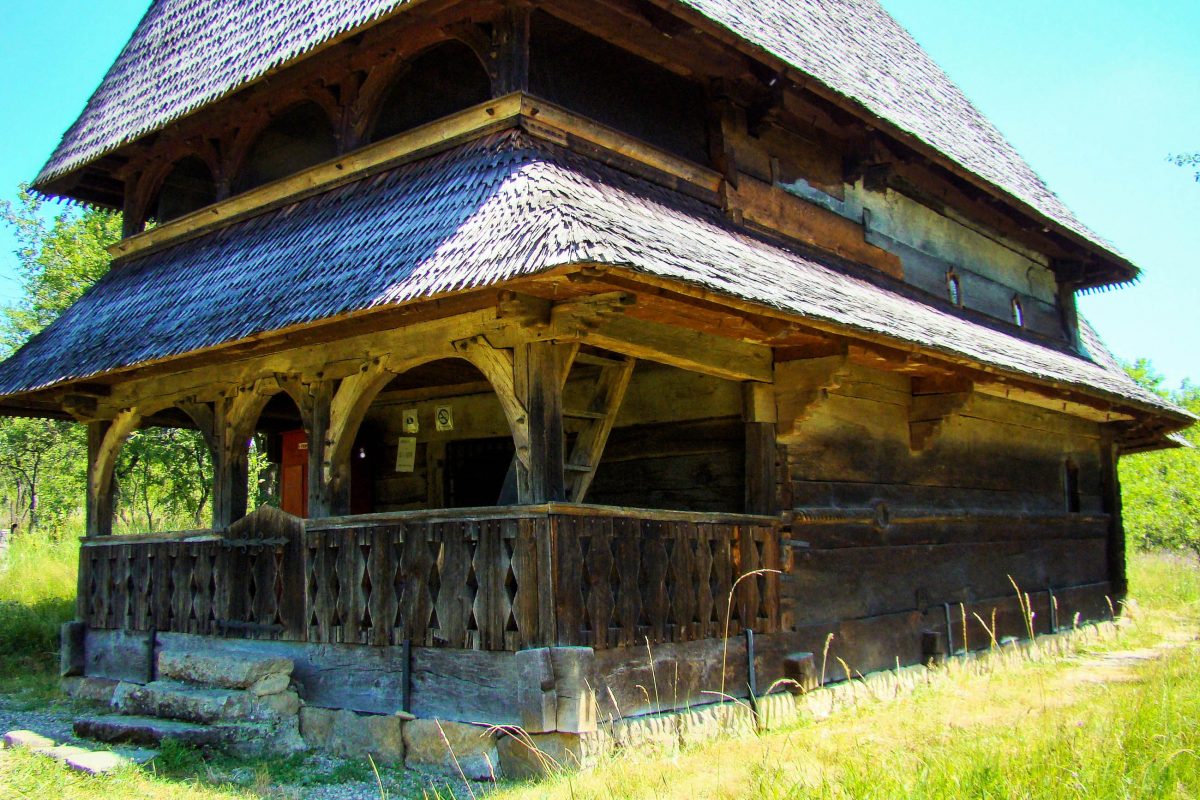
Als das Kloster zerstört wurde, blieb die Kirche verschont und 15 Jahre danach, 1806, wurde die Holzkirche von den Bewohnern Bârsanas an ihren heutigen Standort versetzt, um sie vor Plünderungen zu schützen. Der Legende nach wurde dieser Platz aufgrund eines darunter liegenden Friedhofs für Pest-Opfer ausgewählt, die einst ohne Begräbniszeremonie begraben wurden und so nun zumindest in der räumlichen Nähe einer Kirche ruhen dürfen.
Damit ist die Holzkirche von Bârsana die einzige Holzkirche der Maramureș, die von einer Klosterkirche zur Pfarrkirche wurde.
Besuch der Holzkirche von Bârsana
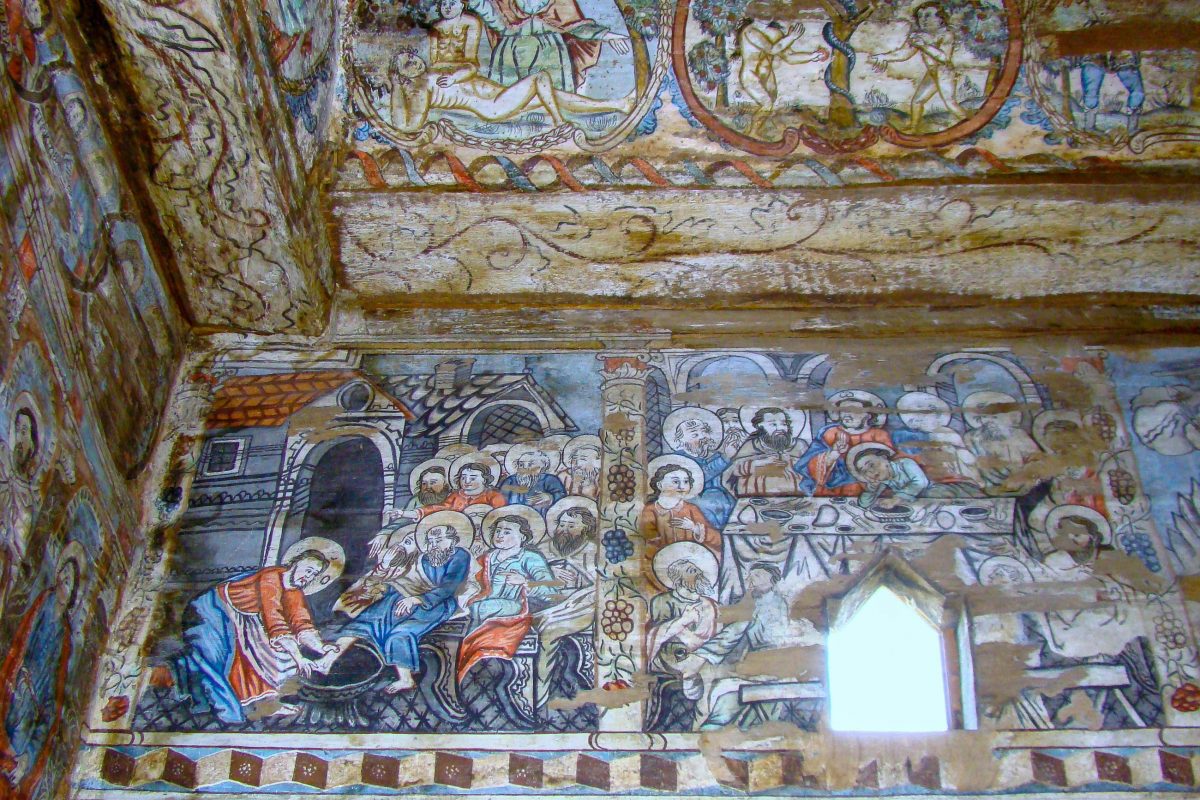
Betritt man die kleine Kirche mit dem mächtigen Spitzdach, verschlägt es einem wohl im ersten Moment die Sprache. Der Innenraum der Holzkirche ist über und über mit prachtvollen Malereien versehen. Scheinbar jeder freie Zentimeter wurde für die Darstellung farbenfroher Szenen aus der Bibel und Bildern von Erzengeln und Heiligen genutzt.
Bei genauer Betrachtung entdeckt man Szenen aus dem Paradies, das letzte Abendmahl, die Rückkehr des verlorenen Sohnes, den Heiligen Georg, wie er den Drachen tötet, die „vieläugigen Cherubim“, die Geburt von Kain und Abel, den Kuss des Judas, die Opferung von Isaac durch Abraham und die Krönung Marias.
Holzkirche und Museum von Botiza
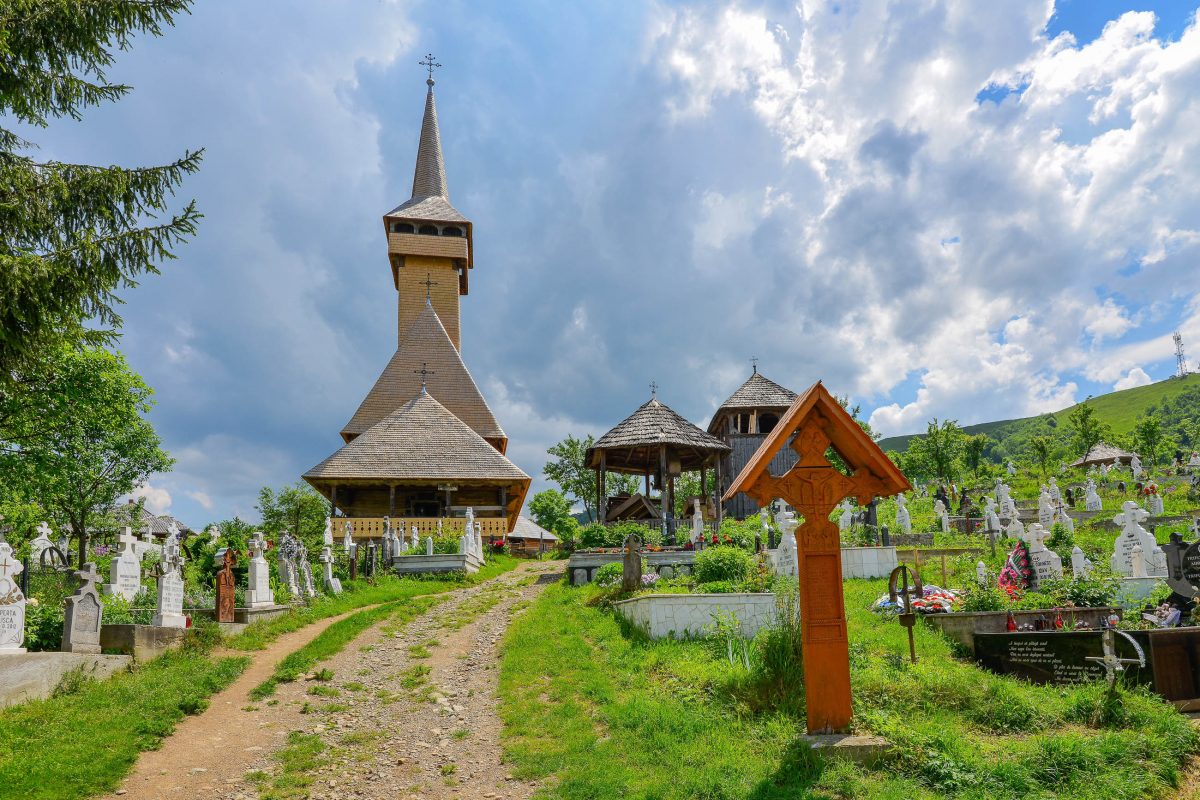
In der kleinen Ortschaft Botiza im abgelegenen Norden Rumäniens könnte die Zeit stehen geblieben sein. Fährt man auf holprigen Straßen durch das Dorf bietet sich ein Bild, das sich in den letzten zwei Jahrhunderten kaum verändert haben kann.
Männer mit Sonnenhüten und Frauen mit Kopftüchern arbeiten mit Sense und Rechen auf dem Feld, Kinder führen Kühe an die Tränke, Frauen sitzen auf sonnigen Bänken vor den Häusern beim Spinnen und Tratschen und auf der Straße trifft man keine Autos, sondern Pferdefuhrwerke, die mit einem duftenden Berg Heu beladen sind.
BILDER: Holzkirche und Museum in Botiza
Fotogalerie: Holzkirche und Museum von Botiza
Heute leben die Einwohner von Botiza nicht nur mehr von der Landwirtschaft, sondern auch zunehmend vom Agrotourismus – in völligem Einklang mit der Natur. Hotels und Restaurants gibt es keine in Botiza, aber mittlerweile rund 100 Zimmer, die von privaten Familien in ihren Häusern vermietet werden.
Zu erkennen an den Schildern „Pension“ oder „Reţea turistică“. Hier ist nicht nur Zimmer und Dusche inklusive, sondern auch Hausmannskost, wie sie mehr bio nicht sein könnte, und ein Eintauchen in den bäuerlichen Alltag der Maramureș.
Besuch von Botiza
Alle Straßen nach Botiza führen über Gebirgspässe denn das verschlafene Örtchen liegt im wahrsten Sinne des Wortes hinter den Bergen. Von Bukarest muss man mit dem Auto eine Tagesreise in Kauf nehmen, die nächstgelegene größere Stadt, Baia Mare, ist knapp 2 Autostunden entfernt. Aus wohl genau diesem Grund ist das abgeschiedene Botiza der exakt richtige Standort für ein Maramureș-Museum.
Maramureș-Museum

Das Maramureș-Museum von Botiza ist bezeichnenderweise in einem traditionellen Landhaus untergebracht, welches, ebenso wie die berühmten Holzkirchen der Maramureș mit Schindeln gedeckt ist und rein aus Holz besteht.
Das „Casa Muzeu“ oder „Casa Berbecaru“ zeigt nicht nur, wie ein echtes Maramureș-Haus innen und außen aussieht, sondern fungiert auch als Pension, Touristeninformationszentrum und Textil-Werkstätte, in der Trachten und andere regionale Stoffwaren entstehen.
Entstehung der Holzkirche von Botiza
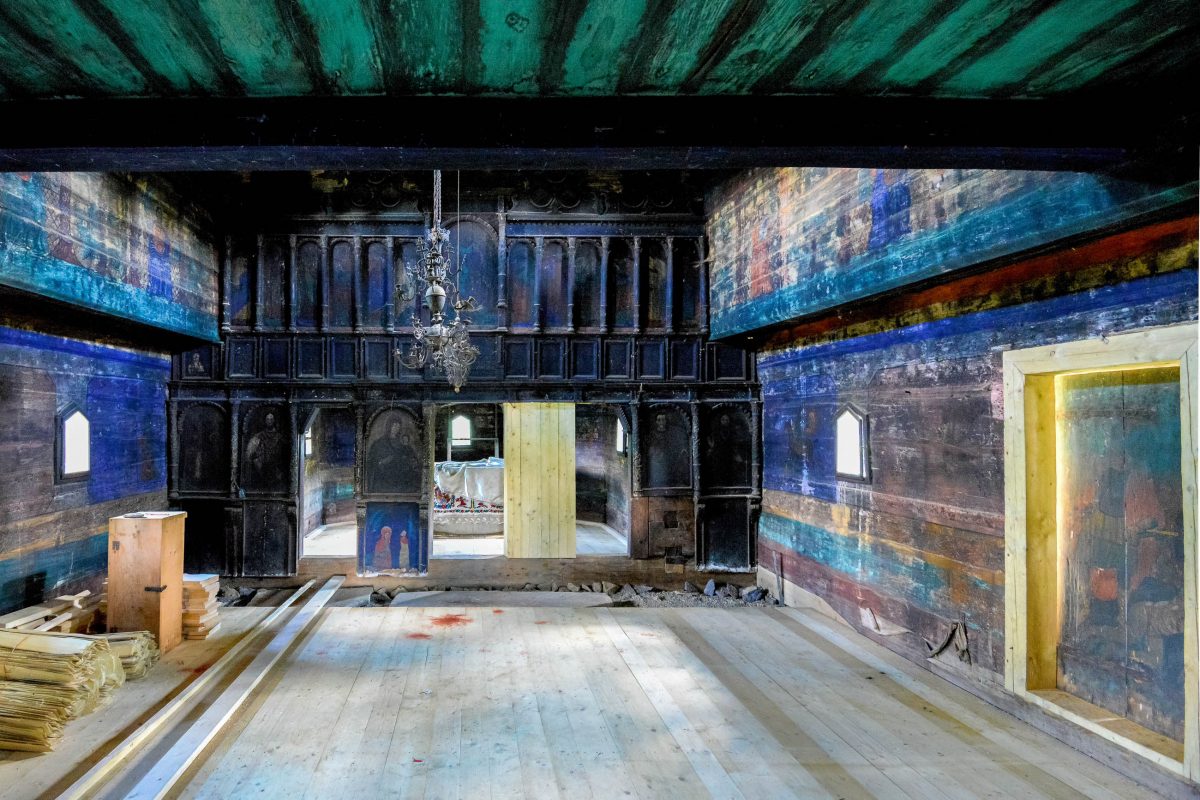
Die Holzkirche von Botiza wurde ursprünglich 1699 in Vișeu de Jos errichtet und der Hl. Paraschiva geweiht, jedoch im Jahr 1899 an ihrem heutigen Platz aufgebaut. Ihre ursprüngliche Bausubstanz ist nicht ganz so gut erhalten geblieben, wie die manch anderer Exemplare und erst um die Jahrtausendwende wurde der Holzbau großzügig renoviert.
Besuch der Holzkirche von Botiza
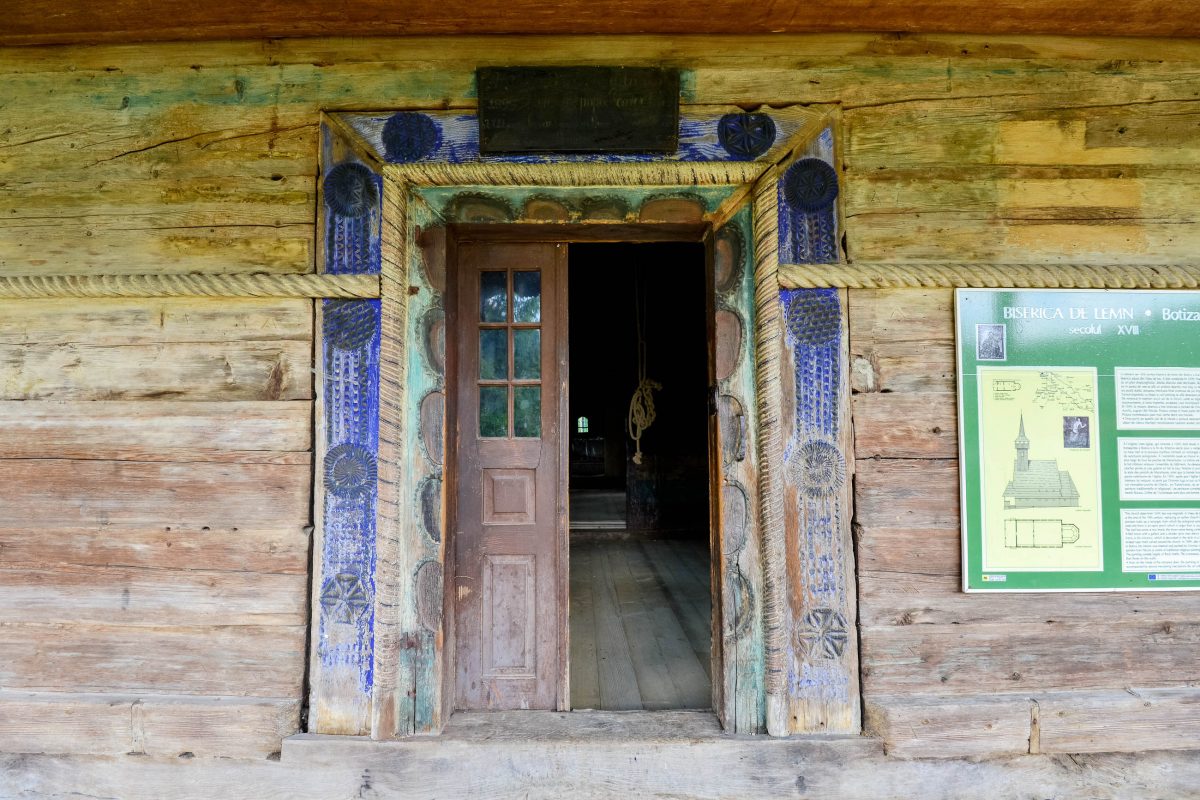
Das Eingangsportal weist die typischen Merkmale eines Maramureș-Tores auf und auch die Balken im Design eines gedrehten Seils, die die gesamte Kirche umfassen, sind typisch für diesen Baustil. Die durch florale Muster geprägten Malereien an den Innen- und Außenwänden wurden 1899 von Dinoisie Iuga und dessen Tochter Aurelia geschaffen.
Zu den bekanntesten Darstellungen der Kirche von Botiza zählt der Tod mit seiner Sense im Innenraum gleich über der Eingangstür. Das mit Warnhinweisen versehene Bildnis wurde jedoch von einem unbekannten Künstler geschaffen. Unter den Heiligenbildern finden sich neben der Madonna mit dem Kind auch der Heilige Georg, der den Drachen besiegt, sowie der Prophet Elias auf dem Streitwagen und der Heilige Dimitrios.
Allerheiligenkirche (Biserica nouă „Duminica tuturor sfinților”)
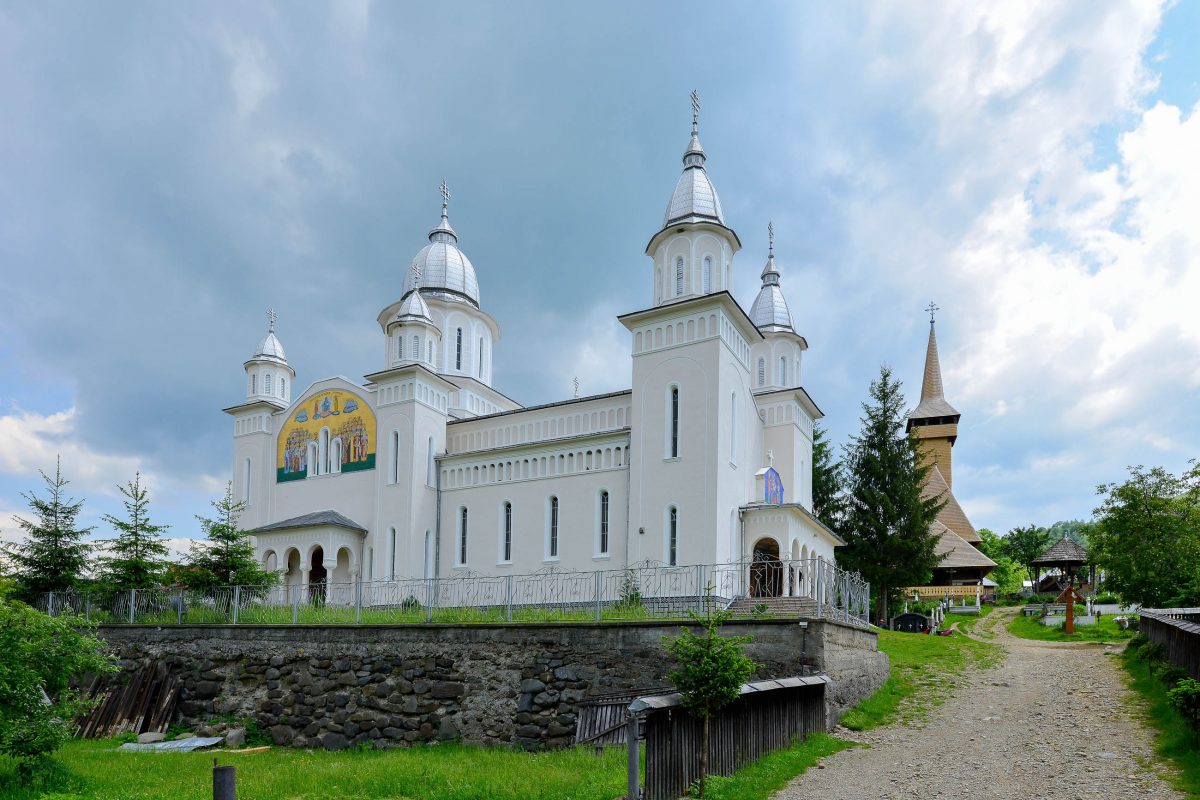
Gleich neben der traditionellen Holzkirche von Botiza bildet die moderne Allerheiligenkirche (Biserica nouă „Duminica tuturor sfinților”) einen starken Kontrast.
Holzkirche von Deseşti
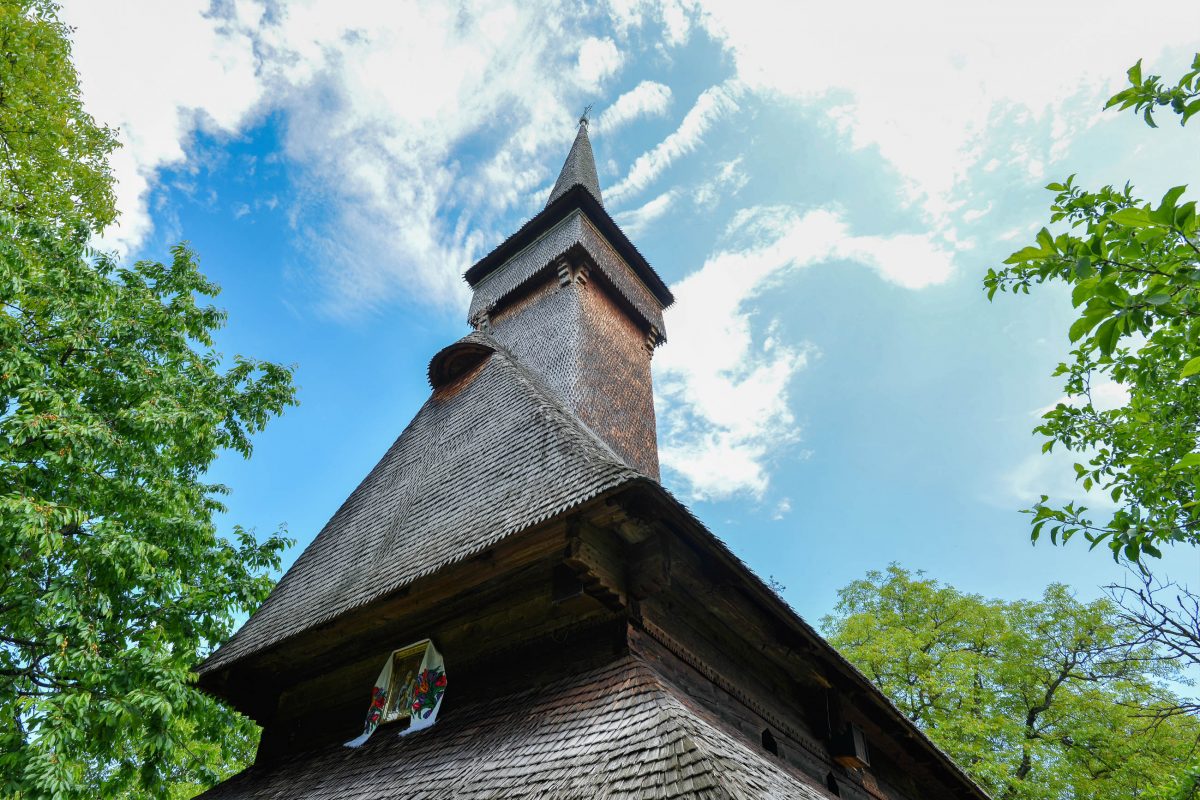
Erbaut wurde die Kirche von Deseşti im Jahr 1770, seit 1999 zählt sie ebenfalls zum UNESCO Welterbe. Für ihre Errichtung wurden lediglich massives Eichenholz und Flusssteine verwendet. Damals wurde sie als „Cuvioasa Paraschiva“ der Heiligen Paraschiva geweiht.
Zehn Jahr nach Baubeginn schuf der Maler Radu Munteanu die eindrucksvollen byzantinischen Fresken in ihrem Innenraum, die bis heute noch jeden Besucher in ehrfürchtiges Staunen versetzen.
BILDER: Holzkirche von Deseşti
Fotogalerie: Holzkirche von Deseşti
Besuch der Holzkirche von Deseşti

Nach Deseşti gelangt man über die DN18, die die beiden Städte Sighetu Marmației und Baia Mara miteinander verbindet. Die Kirche liegt im Westen der Ortschaft und ist – typisch für die Holzkirchen der Maramureș von einem hübschen Friedhof umgeben.
Mit ihrem charakteristischen spitzen Dach, unter dem der Kirchenraum nahezu verschwindet, thront die Holzkirche von Deseşti auf einem idyllischen Hügel mitten in der Ortschaft. Der Aufstieg auf den Friedhofshügel zur Holzkirche von Deseşti erfolgt über eine idyllische Steintreppe.
Auf dem Hügel angekommen taucht bald der elegante Glockenturm mit dem typischen Spitzdach zwischen den Bäumen auf. Neben dem gewaltigen Schindeldach sind auch die sorgfältigen Verzierungen der noch so kleinen Fenster bemerkenswert. Umgeben ist die Kirche von einem malerischen Friedhofs-Ensemble aus Holz- und Eisenkreuzen, sowie Grabsteinen, die mit Blumen geschmückt im Schatten hoher Bäume stehen.
Tipp: Die Kirche ist in der Regel verschlossen, eine Besichtigung des Innenraums jedoch unbedingt zu empfehlen. Für den Schlüssel muss dem Pfarrer von Deseşti ein kurzer Besuch abgestattet werden. Das Pfarrhaus befindet sich von der DN18 kommend ungefähr 100m vor dem Aufstieg zum Friedhofshügel. Eine kleine Spende zur Erhaltung der Kirche wird erwartet.
Kunstvolle Fresken im Inneren
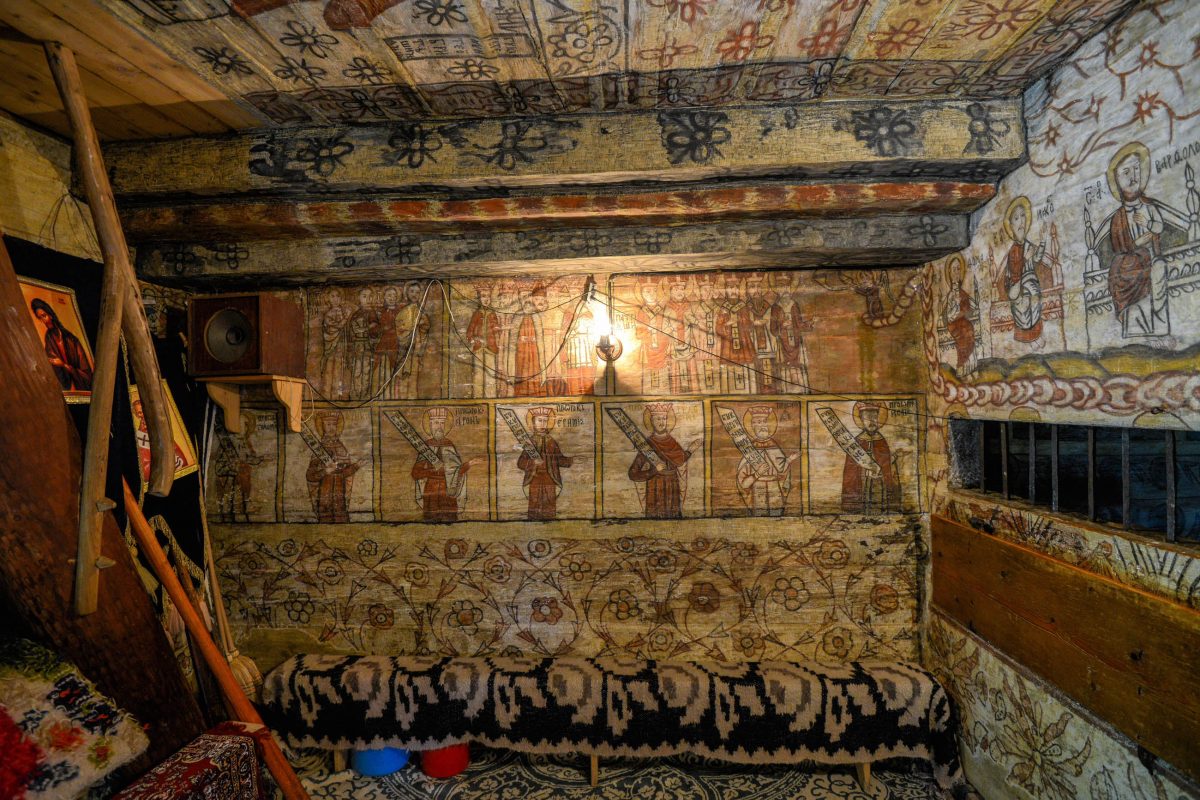
Der Innenraum der Holzkirche von Deseşti besteht aus drei Räumen, die seit 1780 über und über mit kunstvollen Malereien bedeckt sind. Dargestellt sind die typischen Bibelszenen aus dem Alten und Neuen Testament, wie zum Beispiel das Jüngste Gericht, der Leidensweg Jesu und die Schöpfungsgeschichte, aber auch Szenen von Wundern und Gleichnissen. Neben den kostbaren Fresken beeindruckt auch das antike Mobiliar, welches der Kirche eine warme, nahezu heimelige Atmosphäre verleiht.
Nach dem Besuch der Kirche lohnt es sich, noch ein Weilchen ihrer Umgebung zu verweilen und die friedliche Stimmung der umliegenden Natur auf sich wirken zu lassen.
Die Region Maramureș – ein Freilichtmuseum
Die Region Maramureș ist zwar ein bekanntes, jedoch spärlich besuchtes Gebiet Rumäniens. Die hölzernen Dörfer, farbenfrohen Gewänder und traditionellen Bräuche der dortigen Bevölkerung haben sich seit dem Mittelalter erhalten.
Viele der frühen „Kirchentischler“-Familien gehen ihrem Geschäft noch heute nach und so verzieren sie Holzbänke, Hoftore und die Holzkreuze auf Friedhöfen. Somit ist eine Reise zu den Holzkirchen in den Maramures mit einem fantastischen Ausflug in ein Freilichtmuseum zu vergleichen.

